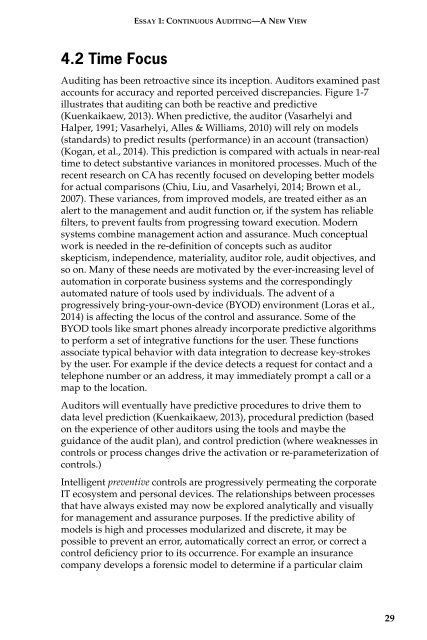AUDIT ANALYTICS AUDIT
1JWn3ix
1JWn3ix
You also want an ePaper? Increase the reach of your titles
YUMPU automatically turns print PDFs into web optimized ePapers that Google loves.
ESSAY 1: CONTINUOUS <strong>AUDIT</strong>ING—A NEW VIEW<br />
4.2 Time Focus<br />
Auditing has been retroactive since its inception. Auditors examined past<br />
accounts for accuracy and reported perceived discrepancies. Figure 1-7<br />
illustrates that auditing can both be reactive and predictive<br />
(Kuenkaikaew, 2013). When predictive, the auditor (Vasarhelyi and<br />
Halper, 1991; Vasarhelyi, Alles & Williams, 2010) will rely on models<br />
(standards) to predict results (performance) in an account (transaction)<br />
(Kogan, et al., 2014). This prediction is compared with actuals in near-real<br />
time to detect substantive variances in monitored processes. Much of the<br />
recent research on CA has recently focused on developing better models<br />
for actual comparisons (Chiu, Liu, and Vasarhelyi, 2014; Brown et al.,<br />
2007). These variances, from improved models, are treated either as an<br />
alert to the management and audit function or, if the system has reliable<br />
filters, to prevent faults from progressing toward execution. Modern<br />
systems combine management action and assurance. Much conceptual<br />
work is needed in the re-definition of concepts such as auditor<br />
skepticism, independence, materiality, auditor role, audit objectives, and<br />
so on. Many of these needs are motivated by the ever-increasing level of<br />
automation in corporate business systems and the correspondingly<br />
automated nature of tools used by individuals. The advent of a<br />
progressively bring-your-own-device (BYOD) environment (Loras et al.,<br />
2014) is affecting the locus of the control and assurance. Some of the<br />
BYOD tools like smart phones already incorporate predictive algorithms<br />
to perform a set of integrative functions for the user. These functions<br />
associate typical behavior with data integration to decrease key-strokes<br />
by the user. For example if the device detects a request for contact and a<br />
telephone number or an address, it may immediately prompt a call or a<br />
map to the location.<br />
Auditors will eventually have predictive procedures to drive them to<br />
data level prediction (Kuenkaikaew, 2013), procedural prediction (based<br />
on the experience of other auditors using the tools and maybe the<br />
guidance of the audit plan), and control prediction (where weaknesses in<br />
controls or process changes drive the activation or re-parameterization of<br />
controls.)<br />
Intelligent preventive controls are progressively permeating the corporate<br />
IT ecosystem and personal devices. The relationships between processes<br />
that have always existed may now be explored analytically and visually<br />
for management and assurance purposes. If the predictive ability of<br />
models is high and processes modularized and discrete, it may be<br />
possible to prevent an error, automatically correct an error, or correct a<br />
control deficiency prior to its occurrence. For example an insurance<br />
company develops a forensic model to determine if a particular claim<br />
29


